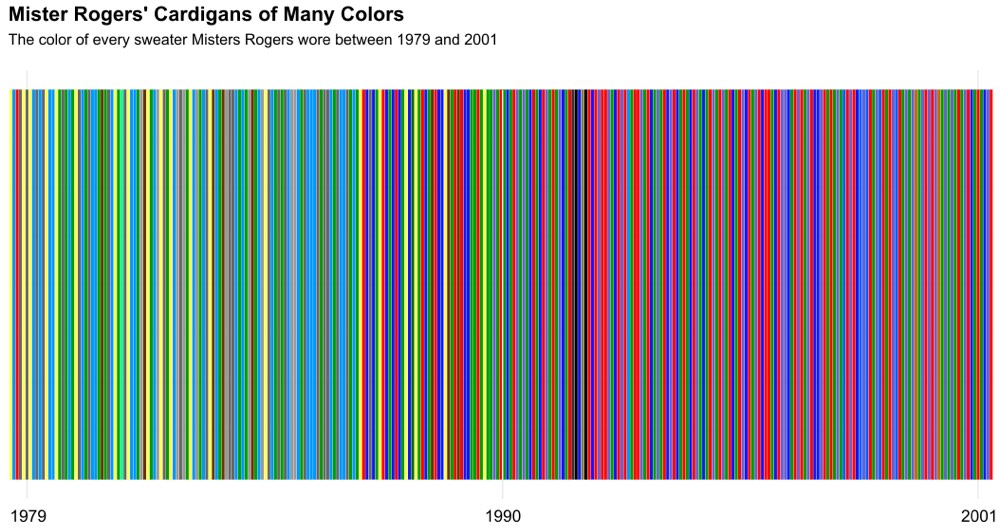The sentimental feelings surrounding “Mister Rogers’ Neighborhood” and its host, Fred Rogers, keep appearing on the Internet. Writers share nuggets of his special kindness and the show’s lessons of civility, all in an effort to be recharged and inspired.
One such piece looks at his sartorial choices. Owen Phillips of The Awl takes on the ambitious feat of charting the colors of Rogers’ cardigans worn on the show.
Phillips sought inspiration from Tim Lybarger, who has curated the homage to all things Mister Rogers in the blog, neighborhoodarchive.com. Lybarger, a high school counselor outside of Champaign-Urbana, Ill., told Phillips via email he decided to chart the sweater colors from each episode from 1979 to 2001 because “such a resource didn’t exist,” and he “felt like somebody needed to do it…might as well be me.”
I remember well Mister Rogers walking through the door changing from his sport coat, singing his iconic tune, seamlessly transitioning into a comfy cardigan sweater and sneakers to sit and speak only with me — a friend in the neighborhood. Early styling as its best!
His attire reminded me much of my own father, who would wear cardigan sweaters and sneaks around our home. Mister Rogers felt approachable, not patrician or patronizing.
Lybarger said via email Rogers’ sweaters “evoke feelings of comfort, warmth, and trust.
“Fred Rogers often talked about how he’d film his programs as though he wasn’t speaking to a mass audience but rather to one specific individual, “ he said. “Kids trust Mister Rogers and the fact that he changes into these cozy sweaters for his television visits with young people just adds to their level of comfort.”
The choices of red, green, blue (light and dark), yellow, purple and gray appeared throughout, many of which were hand knitted by Rogers’ mother. But green and red appeared most often, with green outpacing the red tones by 74 to 54, respectively, according to Phillips’ analysis.
But, of course, Mister Rogers, would gravitate to green. Serendipitously, it aligns with the sentiments of Pantone’s Color of the Year: Greenery, which is a “refreshing and revitalizing shade” and “signals consumers to take a deep breath, oxygenate and reinvigorate,” according to the site.
Leatrice Eiseman, executive director of the Pantone Color Institute, says on Pantone’s site the color greenery provides “us with the reassurance we yearn for amid a tumultuous social and political environment. Satisfying our growing desire to rejuvenate and revitalize, Greenery symbolizes the reconnection we seek with nature, one another and a larger purpose.”
Lybarger said via email everything on the program was “meticulously calculated” and had yet to find the “secret code” to the “why?” behind the sweater colors.
I think we just might have cracked the code.
Sidebar:
While Fred Rogers’ sweaters evoked comfort and cozy feelings, today’s menswear cardigans send out different vibes — ones that marry high fashion with traditional aesthetics.
According to WGSN, spring’s cardigan maintains its traditional V-neck details but takes on a resortlike feeling, expressed in soft tones of ocean blues and olive and abstract stripes.
In local stores, the traditional hand-knit feel, with zippers or buttons, appears in private label Saks Fifth Avenue and Polo Ralph Lauren, respectively. The colors: black, navy blue and speckled gray.
Author: Lisa Lenoir (Executive Member – FGI Kansas City)
Lisa Lenoir is a freelance writer. She teaches fashion communication at Stephens College in Columbia, Mo., and is a Fashion Group International, Inc., member.
